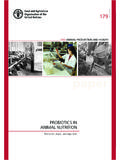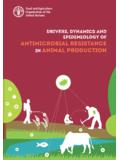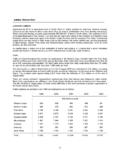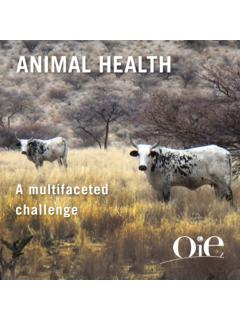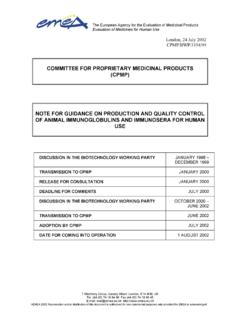Transcription of World Health Organization, Geneva 10 January 2007
1 A NEGLECTED A NEGLECTED PUBLIC Health ISSUEPUBLIC Health ISSUER eport of a Consultative MeetingWorld Health organization , Geneva 10 January 2007 ISBN 978 92 4 156348 2 The aim of this Consultative Meeting was to discuss strategies for improving the quality and quantity of therapeutic antisera, essential drugs for the effective treatment of suspected rabid dog bites and envenoming by snake bites and scorpion stings. Inadequacies in the effi cacy, safety and production of these antisera have created a major global public Health crisis, especially in Africa and Asia. Each year, millions of people are bitten by dogs or snakes or stung by scorpions and the failure to provide antisera costs at least 200,000 lives and at least as many cases of permanent physical handicap. The solution to this crisis demands an international effort to promote transfer of technology to affected countries, to improve standards through the WHO s prequalifi cation scheme and to facilitate distribution of antisera and training of medical personnel in their optimal Assurance and Safety: Blood Products and Related BiologicalsDepartment of Medicines Policy and StandardsHealth Technology and Pharmaceuticals ClusterWorld Health Organization20, Avenue AppiaCH-1211 Geneva 27, SwitzerlandTelephone 41 22 791 3892/ 3395 Fax 41 22 791 4730e-mail: NEGLECTED A NEGLECTED PUBLIC Health ISSUEPUBLIC Health ISSUER eport of a Consultative MeetingWorld Health organization , Geneva 10 January 2007 Design & Layout.
2 WHO GraphicsAll photographs Professor David WarrellPrinted in FranceWHO Library Cataloguing-in-Publication DataRabies and envenomings : a neglected public Health issue : report of a Consultative Meeting, WHO, Geneva , 10 January drug therapy. epidemiology. 3. Bites and stings drug therapy and stings epidemiology. , Passive utilization. economics industry economics. Health 978 92 4 156348 2 (NLM classifi cation: WD 400) World Health organization 2007 All rights reserved. Publications of the World Health organization can be obtained from WHO Press, World Health organization , 20 Avenue Appia, 1211 Geneva 27, Switzerland (tel.: +41 22 791 3264; fax: +41 22 791 4857; e-mail: Requests for permission to reproduce or translate WHO publications whether for sale or for noncommercial distribution should be addressed to WHO Press, at the above address (fax: +41 22 791 4806; e-mail: The designations employed and the presentation of the material in this publication do not imply the expression of any opinion whatsoever on the part of the World Health organization concerning the legal status of any country, territory, city or area or of its authorities, or concerning the delimitation of its frontiers or boundaries.))
3 Dotted lines on maps represent approximate border lines for which there may not yet be full agreement. The mention of specifi c companies or of certain manufacturers products does not imply that they are endorsed or recommended by the World Health organization in preference to others of a similar nature that are not mentioned. Errors and omissions excepted, the names of proprietary products are distinguished by initial capital letters. All reasonable precautions have been taken by the World Health organization to verify the information contained in this publication. However, the published material is being distributed without warranty of any kind, either expressed or implied. The responsibility for the interpretation and use of the material lies with the reader. In no event shall the World Health organization be liable for damages arising from its use.
4 This publication contains the collective views of an international group of experts and does not necessarily represent the decisions or the stated policy of the World Health Report was developed by compiling the information provided at the WHO Consultative Meeting on RABIES AND ENVENOMINGS: A NEGLECTED PUBLIC Health ISSUE that took place at WHO, Geneva on 10 January 2007. It was prepared by Professor D. Warrell, University of Oxford, Oxford, United Kingdom and Dr J-M Gutierrez, Universidad de Costa Rica, San Jos , Costa Rica that served as Rapporteurs and Dr A. Padilla, Project Leader, WHO. Acknowledgements are due to all the participants for the information and comments provided during the Consultative Meeting. Special thanks are due to the speakers for their excellent presentations and written comments in support of the preparation of the 1 INTRODUCTION 3 Chapter 1 RABIES AND ENVENOMINGS: neglected diseases 5 Chapter 2 EPIDEMIOLOGY: the burden of disease 13 Chapter 3 PRODUCTION AND CONTROL OF THERAPEUTIC ANTISERA 16 Chapter 4 DISTRIBUTION AND APPROPRIATE USE OF THERAPEUTIC ANTISERA: failure to supply those at greatest need 21 Chapter 5 SCALES OF PRODUCTION: the need to strengthen capacity 23 Chapter 6 PREQUALIFICATION OF ANTISERA: the way to improve access to quality and safe products 25 Chapter 7 TOWARDS A GLOBAL SOLUTION.
5 A WHO initiative to improve availability of safe antisera 26 REFERENCES 29 LIST OF PARTICIPANTS 311 SUMMARYThe people most affected by rabid dog bites, snake bites and scorpion stings usually live in poor rural communities where medical resources are often sparse. Because they lack a strong political voice, their problems tend to be overlooked by politicians and Health authori-ties who are based in capital cities and are poorly informed about major public Health issues affecting rural areas. Consequently, the impact of these Health issues, although dramatic and economically signifi cant, does not appear as a priority in the design of national public Health programmes. These are therefore the most neglected among today s neglected global Health problems. The gravity of this situation should be discussed explicitly in national, regional and global Health fora, in order to give these neglected diseases and their abandoned victims the atten-tion they deserve.
6 The situation is particularly poignant because, in contrast to some other diseases, a highly effective treatment already exists: the timely administration of specifi c antiserum. Rabies, for instance, is entirely preventable even after severe exposure, provided post-exposure prophylaxis, completed with rabies immunoglobulin, can be given. Similarly, the mortality and morbidity of snake bites and scorpion stings can be reduced to very low levels by timely administration of appropriate antivenoms. The state of antisera production worldwide varies greatly. Public access to production technology following GMP standards, together with a concerted exchange process through workshops, direct technical assistance and innovation in specifi c aspects of manufacture and training, should allow the less developed manufacturing laboratories to strengthen their technical and production capacities.
7 The possibility of partnerships should be promoted, including, in the case of antivenoms, the creation of groups developing the skills needed for the preparation of high quality venom pools and the subsequent preparation of summary, the current situation of the management of potentially rabid mammal bites and envenomings by snake bites or scorpion stings worldwide is a global public Health emergency. There is a lack of awareness of the magnitude of the problem by Health authorities and politi-cians alike, due to both the scarcit y of adequate statistics on the real impact of these diseases, and the lack of advocacy by and on behalf of the affected groups, mostly children and rural agricultural workers. Worldwide production of these antisera has declined, due to economic constraints that have forced the withdrawal of some private producers, and to the weakening of public-sector manufacturers in the public sector in many countries.
8 Moreover, the poor quality of some antisera and the resulting defi ciency in their effi cacy and safety, together with defi cient distribution policies and inadequate training of medical and nursing staff requires an urgent international action. The gravity of this problem, and the complexity of its causes, demands from the public Health community, and especially from the WHO and humanitarian international agencies, a concerted, rapid and effective global response to reduce the burden of human suffering incurred by rabies, and snake and scorpion meeting of stakeholders to discuss measures to ensure sustainable production of effective and safe therapeutic antisera1 for treatment of rabid dog bites and envenomings due to snake bites or scorpion stings was convened by the Department of Medicines Policy and Standards, Health Technology and Pharmaceuticals Cluster, on 10 January 2007 at the World Health organization (WHO) Headquarters, Geneva .
9 This was the fi rst meeting held by the WHO to address the need for strengthening the production systems of these biological preparations at a global level. Animal-derived antisera are the only effective treatments of envenoming, and are essential, in combination with vaccination and wound maintenance, for post-exposure rabies than 40 participants from countries representing all WHO Regions were welcomed to the Consultative Meeting by Dr. Howard Zucker, Assistant Director General of the WHO Health Technology and Pharmaceuticals Cluster, and Dr. Hans Hogerzeil, Director, Medicines Policy and Standards Department. It was noted that there is a growing crisis in the production, accessibility and use of therapeutic antisera in regions where snake bites, scorpion stings and exposure to rabies have their greatest public Health impact.
10 These neglected public Health conditions affect more than 14 million people annually, especially in the developing World ; yet, effective treatment, critically dependent on therapeutic antisera ( rabies immunoglobulin and antivenoms), is often unavailable or unaffordable, in particular in Africa and Asia. This results in high mortality and morbidity with grave socioeconomic consequences. Children and young agricultural workers are the worst affected by these conditions. Therapeutic antisera are included in the WHO Essential Medicines List (1).The shortage of therapeutic antisera has become a critical global Health issue. Many manufacturers in the developed World have abandoned production of antisera because of market limitations in countries with developed economies. In developing countries, the remain-ing producers of antisera are vulnerable to fl uctuations and uncertainties in market demand, to private takeover of former national companies, and to the lack of fi nancial investment to upgrade the facilities to comply with good manufacturing practices (GMP).











